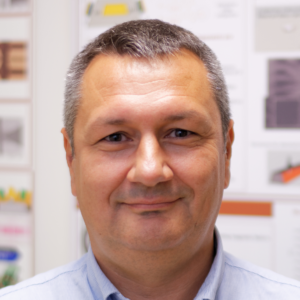Overview
The Magnetic Random Access Memories (MRAM) group develops advanced concepts in this emerging technology. The goal is to realize cells with improved thermal stability, lower power consumption and/or faster switching. Our research covers material stack deposition, nano-fabrication and electrical test evaluation, for applications as standalone memory and non-volatile logic and more recently in neuromorphic computing architectures.
Research directions
Perpendicular Anisotropy Materials
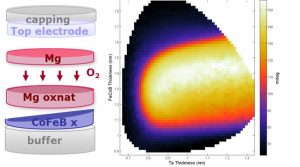
High energy barriers for spin transfer torque (STT) MRAM cells can be achieved with perpendicular anisotropy magnetic tunnel junctions. Solutions for high density MRAM cells to diameters below 20nm require continuous improvements in perpendicular surface anisotropy, while maintaining high TMR properties.
Perpendicular STT MRAM
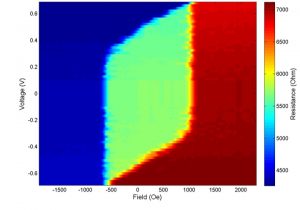
Evaluation of MRAM concepts requires simulation of expected reversal mechanisms and electrical characterization of individual cells. We aim at understanding dynamics of magnetization reversal and the expected impact of stack modifications to explore application specific optimizations.
Nanofabrication Challenges
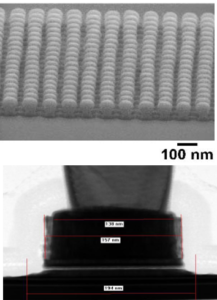
Innovation on dense MRAM using pre-patterned substrates, CMOS integration of multifunctional cells and sub-10nm lateral sizes. Tunnel junction nanofabrication in our platform is essential to evaluate MRAM concepts and performance.
Perpendicular Shape Anisotropy
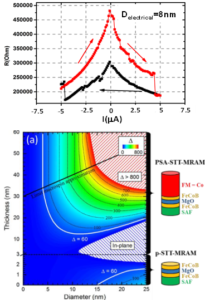
A solution for sub-10nm cell sizes uses high aspect ratios to generate perpendicular shape anisotropy providing scalable retention at the smallest cell sizes. Spin transfer torque switching is possible in these cells, where the reversal dynamics is now under study.
The team
Former members
Post-docs
- Andrey TIMOPHEEV (2014-2017)
- Van Dai NGUYEN (2016-2018)
- J. Ranier Roiz (2015-2016)
- Nikita Strelkov (2016-2019)
PhD
- Luc TILLIE (2015-2018)
- Nicolas PERRISSIN (2015-2018)
- Jyotirmoy CHATTERGEE (2014-2017)
- Hieu Tan NGUYEN (2013-2016)
- Antoine Chavent (2013-2015)
Process Engineers
- Jude GUELFFUCCI (2015-2017)
- Nathalie LAMARD (2016-2017)
- Guillaume LAVAITTE (2015-2016)
Projects
- Samsung SGMI (2014-2017)
- ANR Excalyb (2014-2017)
- Heumem (2015-2018)
- EU-FET Spice (2016-2019)
- EU Great (2016-2019)
- ERC Magical (2015-2020)
Partners
- CEA LETI, Grenoble, France
- Institut NEEL, Grenoble, France
- Crocus Technology, Grenoble, France
- Samsung, San Jose, USA
- Singulus AG, Kahl am Main, Germany
- Aarhus University, Aarhus, Denmark
- Radboud Universiteit, Neijmegen, Netherlands
Recent news
- Seminar – Symmetry aspects of antiferromagnets and altermagnets (June 20th, 2025)

On Monday June 30, 2025 at 14:00 Sergey A. NIKOLAEV from Osaka University (Japan) will give online seminar entitled: Symmetry aspects of antiferromagnets and altermagnets Video conference: https://univ-grenoble-alpes-fr.zoom.us/j/98769867024 Meeting ID: 987 6986 7024 Passcode: 025918 Abstract: Antiferromagnets being an ... - Seminar – Spin dynamics and magnetotransport in ultra-low damping Co100-xFex layers (June 10th, 2025)

On Wednesday June 11, 2025 at 13:00 we have the pleasure to welcome Luis AVILES FELIX from Instituto de Nanociencia y Nanotecnología (CNEA-CONICET), Bariloche (Argentina). He will give us a seminar entitled: Spin dynamics and magnetotransport ... - Post-Doctoral and fixed term R&D Engineer openings at SPINTEC (December 16th, 2024)

Project: SPINTEC offers several 24-month positions for postdoctoral researchers or research engineers, funded by the EU and French National Research Agency ANR. The projects focus on spintronic innovations for a sustainable digital technology, emphasizing advanced ... - Impact of external magnetic field on Spin Transfer Torque magnetic memory operation (December 09th, 2024)

The extent to which an external magnetic field can influence the operation of Spin-Transfer-Torque Magnetic Random Access Memory (STT-MRAM) remains a critical question within the microelectronics industry in particular regarding its use in automotive industry. ... - Seminar – Selected applications and trends in magnetoresistive sensors (November 25th, 2024)

On Friday November 29, 2024 at 13:30 we have the pleasure to welcome Johannes Paul from SENSITEC. He will give us a seminar entitled: Selected applications and trends in magnetoresistive sensors Place: IRIG/SPINTEC, CEA Building 10.05, auditorium ...







